Nothing compares to a good orange juice in the morning. Perhaps this is one of the reasons why we like it so much: it is the ideal morning companion.
If we add to this the large number of benefits it provides to our body and the fact that they are grown in Valencia, at Campos del Abuelo we have several reasons to feel proud of bringing this fruit from the tree, directly to your home and without post-harvest chemicals.
We have all heard at some point that Valencian oranges are the best in the world. That is why, in this article, we will try to answer the following question: Why is there so much fame?
So if you are here because you want to know everything about the Valencia orange , come on! The journey has just begun.

To talk about why the best oranges in the world grow in these lands, we have to take into account the following factors: The location, the quality of the soil and the climate.
Together, they make Valencia the ideal place to grow the best oranges. They even have international recognition, and it is no wonder: it is a great land of farmers who, with effort and dedication, have earned their place.
To talk about the process of this delicious fruit, we will be accompanied by the words of Eduardo, founder of Campos del Abuelo and Valencian orange farmer .
He comes from a family with a long tradition in the countryside. His great-grandparents began farming at the beginning of the 20th century. So, well, he knows a lot - a lot - about the subject.
Before continuing, remember that on our website you can buy the best Valencia oranges directly from our fields and all online , with deliveries in less than 24 hours.
That said, let's move on to learn, with Eduardo, the origin of the orange, how it is grown, what care needs to be taken into account and the varieties that we can find.
Oh, and if you are interested in learning more about orange groups and varieties, you can read this article on the subject.
The origin of the Valencian orange: a pride with centuries of history
There is a lot to say about oranges. According to our farmer Eduardo: it is a fascinating world , so we will get to know it little by little. But to do that we must start at the beginning. Shall we?
Etymology of the word orange
To talk about the origin of the orange, we will go back to the beginning of everything: Well, we are not going to the Big Bang, but to the etymology of the word orange. The wise men say that something does not appear until it is named…
The word comes from the Sanskrit “ nāraŋga” meaning “orange tree”, “tree that gives oranges” . From there it passed to the Persian “nārang”, and from Persian to Arabic, a language in which the word “nāranğa” was added to refer to the fruit.
Then, in the Middle Ages, it was introduced into Europe with that name that ended up being adapted to “orange tree” for the tree and “orange” for the fruit , as we know it today.
With this doubt resolved, we can now leave linguistics aside and move straight to agriculture...

Distinction between sweet and bitter
Bitter oranges , scientifically known as Citrus aurantium , are cultivated for ornamental purposes or for perfumery, but not for consumption. Today, they are also cultivated as raw material for jams, liqueurs and essential oils.
If you have visited our land, you will know that, walking around Valencia, you can find this type of orange trees. They are also known for being border trees , that is, they serve as a rootstock for grafting orange varieties , but they are not for consumption. Be patient, we will talk about rootstock trees and grafts later.
So if you were wondering if you can eat the oranges from the streets of Valencia, well the answer is that you shouldn't because they are bitter oranges ...
On the other hand, the sweet orange or Citrus sinensis , as it is scientifically known, is the one we consume in our homes. The trees themselves are quite similar, but from Campos del Abuelo, we are going to share with you the key to be able to differentiate the sweet orange tree from the bitter orange tree.
That's right, you should pay attention to the stem that connects the leaf to the branch, this stick is called a petiole. In bitter oranges, this stem has little wings shaped like a heart, in sweet oranges it doesn't.
You can see it better in these photos:

Arrival of the orange in Valencia
We are now getting closer to how the orange arrived in our lands. To begin with, we have to take into account that both the sweet and bitter orange come from tropical and subtropical areas of Asia . In fact, most citrus fruits are from Asia, except for the grapefruit, which is the most mysterious of citrus fruits and comes from the Caribbean. But that is another topic.
As for oranges, it is said that they originated in southeastern China and Burma, and then spread to Japan and India. This delicious citrus fruit arrived in the West via the Silk Road.
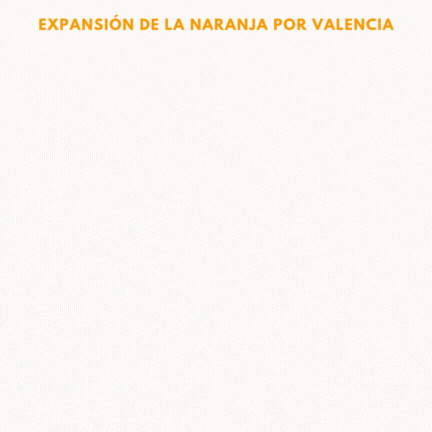
The sweet orange arrived in Spain in the 10th century via the Mediterranean, thanks to Italian and Portuguese traders . Bitter oranges arrived from the south between the 9th and 10th centuries with the Arabs, who used them as decoration.
Well, and not only for decoration, but for the delicious fragrance of its flower known as orange blossom . This flower is a medicinal plant and you can learn about its history, uses and derivatives in this article.
Meanwhile let's continue with the path of the fruit that comes after this pretty flower.

It was only a matter of time before the orange reached Valencian lands. The first record of the sweet orange in Valencia is in 1781 in the town of Carcaixent. After seeing the yields of this plant compared to other crops, farmers decided to change their plantations to citrus.
Before the orange became the crop par excellence of Valencia, it was rice that fulfilled that role. Our orange farmer, Eduardo, tells us about it:
My great-grandparents already had land at the beginning of the 20th century . Here, since there was a lowland and a mountainous area, they first had rice fields in the lowland. Rice was grown because the land was very fertile and produced many kilos of the same crop.
In the higher areas there were olive trees, but then they devised a system to raise the water with some old motors and planted orange trees . They gradually gained ground and now it is all orange trees and persimmons .

I wonder if those first growers even imagined they were laying the foundations for transforming Valencia into the land of oranges. We will never know for sure… Anyway, let’s move on now, because the story continues… And there are pests in the middle and everything.
In the mid-19th century, Portugal was the main competitor in orange exports, but in 1850 the Portuguese orange trees were invaded by a plague of parasites that wiped them out in a few years.
This, together with the development of railway connections in the Valencian community, meant that it was able to position itself ahead of other Spanish regions in orange exports to countries such as Holland, the United Kingdom, France, Germany and Belgium. Little by little, everything began to turn Valencia into the land of sweet oranges par excellence.
Currently, there have been ups and downs due to the different political and social stages that the country has experienced, but Valencia has managed to maintain itself as a world leader and as the largest producer of oranges in Spain.
And here not only are oranges planted, but it is also land of citrus growers , so we also find fields of mandarin oranges , lemons and grapefruits.

Getting to know orange cultivation in Valencia: from planting to harvesting
It is well known that there are places around the world where the cultivation of some fruit or vegetable becomes something iconic. And there is no doubt about it: Valencia is dyed orange .
We have already seen its origins, it arrived in these lands early and adapted as if it were destined to be cultivated here. Now, to know everything about the famous Valencian oranges we have to start at the beginning.
How are orange trees planted?
Eduardo has years of tradition in orange cultivation and it shows when he speaks. He does it with passion, but also with deep, ancestral knowledge. Because -as he tells us- his family has been living agriculture from the inside for a long time:
We are now in our fifth generation, and as far as we know! Because before that, it was the same, but we are lost there… I suppose my great-great-grandparents had land because this area lived off of agriculture. People still live off it, but less and less. But I have proof that we have worked the land since my great-grandparents .
So you must surely know how various crops are planted, but since we are here to learn more about the Valencia orange, we asked you about it:
Small orange trees come in root balls and are planted bare-root. They are in the nursery, they are pulled up with bare roots, they are brought here, with the root protected so that they do not lose moisture, and they are planted in the ground.
As I was saying, the plant is bare-rooted, that's all. At the beginning you have to be careful not to water it too much because if you water it too much it becomes lazy and doesn't put out roots because it doesn't seek moisture.

Eduardo has seen how small orange trees are planted because at the beginning of the 70s he had to live through a very difficult time in the countryside…
In the early 1970s, all the orange trees died from a disease called La Tristeza , a bacteria that had no cure and affected the orange trees. These were a type of bitter orange tree that existed at that time and were very sensitive to this disease.
It was a very good plant, it produced a lot of good fruit, but it had this problem and when the bacteria got into it, they all died and were uprooted. As they died, the plantations were uprooted and planted again.
If there is one thing that is always present in working the land, it is effort. And not only because it is very costly, but because there is always the possibility of losing everything. But, as Eduardo says, one must continue forward:
This bitter rootstock was replaced by roots that are tolerant to La Tristeza . Like the varieties we have here, which are Cleopatra and Carrizo , because the plantations were made when those two existed, now there are some more modern ones.

These varieties that Eduardo calls “bitter foot” are the ones that are grafted so that they later bear fruit , we will see this later. Meanwhile, our farmer tells us a little more about these two varieties of border trees that he still keeps in his fields:
Carrizo is a plant that produces thicker fruit and produces it a few days earlier, 15 or 20 days earlier than Cleopatra. Cleopatra produces smaller fruit and comes later, but when it comes to producing it is more balanced. Carrizo is more delicate and sensitive to humidity, they die earlier, Cleopatra lasts much longer. Both are good.
How do you get an orange tree to bear fruit?
The orange tree is considered a medium-sized tree, it can measure from 5 to 12 meters in height, but generally, when they are cultivated trees, they grow from 3 to 5 meters . They have a well-rounded main trunk, made of hard wood.
Its branches appear one metre above the ground, and its leaves are evergreen (they are on the tree all year round), medium-sized, elongated and pointy. And if you have had the chance to see one in person, you know that when they are covered in orange, they are very beautiful.
And now, with the image of the orange tree in mind, we have reached the moment to return to the subject of the foot or border trees . Like other fruits such as the avocado , the orange tree needs to be grafted to produce good, quality fruit .
The graft will be carried out according to the variety of orange tree that we choose. For example, we can graft a rootstock or vine with the Valencia Late orange variety or the Navelina orange variety. Later on we will learn more about the varieties that are grown in Valencia.

In order to graft the tree, certain factors must be taken into account. It should be done in spring , when it starts to get warmer and there is a greater chance of rain.
The procedure we will describe below is a so-called “lateral” graft , you will see why. Likewise, there are other ways of grafting trees, but we will take this type as an example. Well, let’s go then.
Once we have chosen the border tree to be grafted, a T-shaped cut is made and, with the same knife, the bark is lifted. If it lifts easily, the tree is ready to be grafted. You can see this in the following images:

So, what we do is look for a branch of the tree of the variety we want . For example, we look for the branch of a tree of the Navelina orange variety.
The branch must be vertical, strong and vigorous. Once it is chosen, a small portion is cut off and inserted into the bark of the tree where the T-shaped cut had already been made.
Once the piece of stick has been placed in the cut, tape is applied to hold the graft in place and inside the bark of the tree . You can see this in the following images:

It may sound a little strange if you haven't heard of this, but the process is as follows: Place a small piece of the tree of the variety you want on the border tree.
Once you are an expert in grafting, you can change the variety on the tree several times at different times. There is no doubt that the way nature works is amazing.
Well, let's continue with Valencia oranges, which, as famous as they may be, have a cycle to complete in the plant and we are about to discover it.
What is the cycle of the Valencian orange?
When we asked our experienced farmer about the orange cycle, he answered very precisely... They follow the following process: sprouting, flowering, setting, growth, ripening and harvesting .
Budding occurs in April or October, in autumn and spring, which are similar. In turn, what sprouts on the autumn buds, produces the flower in spring.
And that's where we are right now. We've already gone through winter and spring has given its flowers. It seems incredible what Eduardo says, that the flowers we see in spring began their budding process in autumn.
They have waited so long to come out into the sun and now they are ready. Everywhere we see colours, bees, bumblebees and butterflies. It is as if the air smells different.
Even more so if you are in an orange grove, the orange blossom aroma is so delicious that it is used in perfumery and baking… But let's continue with our subject, which is spring, the famous Valencia orange trees are already in bloom, and the beautiful five-petaled white flower, the orange blossom , has made its appearance.

When the petals fall, we begin what is known as cell division , which is when the fruits begin to set . But - be careful - not all the flowers on the tree end up being fruits, nor will all the small fruits that set survive.
Fruit setting is the moment when farmers know that the fruit will not fall and will eventually survive . This is a very important part because sometimes, due to various factors, such as excessive rain, the flower rots and the fruit does not set properly.
Regarding rain during the orange cycle, Eduardo has more to offer us, because it seems that sometimes it is not welcome and other times it is…
Rain during the flowering period is bad because it can rot the flower. But from May onwards, when the orange has set, if it rains it is good because the orange takes on size.
It is important that it rains, especially in winter, at the beginning of spring, but before the flower buds appear , and then, once the orange has set. In summer, if there is a shower, it is great because it cleans the tree and makes it healthy.
As with everything, what we are looking for is a balance , this is what our farmer tells us:
Too much or too little rain is bad. It has to rain in normal amounts so that it doesn't affect the tree. Too much can cause fungus, for example. The most delicate thing is when the tree is flowering.
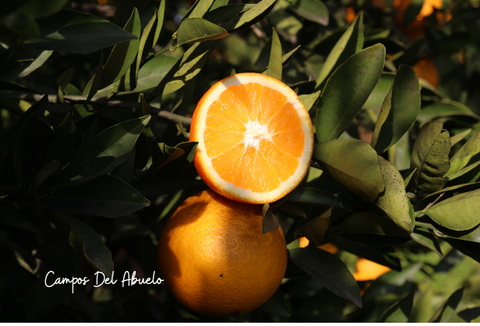
In this setting phase, each of these -still tiny- oranges fights to absorb the greatest amount of nutrients from the soil, water and sunlight.
Eduardo also has something to share about the importance of trees receiving the nutrients they need:
For both flowering and fruit set, the tree uses the reserves it has from the previous year . That is why it is so important that the trees are well fertilized in the months of September, October and November so that they are strong and that the spring flowering takes place well.
While the orange is hanging, you fertilize it. The spring flowering takes place the year before, in the summer months of the previous year, the tree has to be well fed , well nourished.
When this struggle for carbohydrate absorption begins, a purge occurs and the tree itself gradually leaves aside the fruits that have achieved the least weight gain.
Thinning work can also be carried out , which consists of removing the weaker or malformed fruits manually to leave the stronger ones. It may also happen that there is an excess of set fruit . This work is common and is also carried out on apple and avocado trees .
This would lead us to have many fruits on the tree that are of low caliber , that is, with little growth and small. This happens because the tree does not have enough nutrients to grow them all . This is not good because the small fruit - although it is our favorite as it concentrates the greatest amount of sugar and sweetness - is not commercial.

The ideal, once again, is to have a balance so that the tree is not plagued with fruit, but not poor either. It doesn't sound easy, does it? Thank goodness at Campos del Abuelo we have experts to guarantee that the best oranges arrive at your home.
Well, once the strongest fruits have remained on the orange tree, the ripening season begins , and with it the heat. And this is when you have to take into account a very important factor: irrigation .
Orange trees love water and need it when the heat hits because, even though it is a tropical fruit and likes the heat, it loves water. And if rainwater is not enough, it is time to water. The optimal time is 3 or 5 days if the irrigation is localized by drip or every 15 or 20 days if it is by flood irrigation.
In the case of irrigation, the traditional method is flood irrigation, which is why if you travel to a field in Valencia, you can see the channels through which the water flowed. Now, as Eduardo tells us, this is changing to make way for drip irrigation, which is more efficient:
Flood irrigation is being phased out, not so much because more water is consumed, but because the water consumed is similar. What happens is that from the moment it leaves the river through the canals to the field, it is filtered and a lot of water is lost, whereas in drip irrigation it goes through pipes and practically all of it is used.
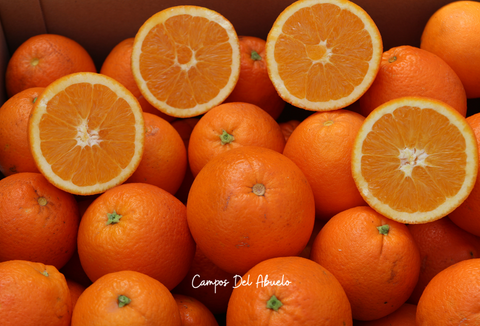
It is also important to take into account pruning when growing oranges (which is like a haircut for the tree). Some branches are weak and it is better to remove them so that the tree does not waste its energy in vain. In addition, pruning allows the sun to reach most of the leaves. We do this every year.
Something that used to be done but is no longer done for ecological reasons is fighting weeds that grow around trees. In the past they were seen as competition for our trees, but today we work in an ecological way.
We aim for a symbiotic relationship between the growing herbs and the trees, as they receive some benefits such as nutrients but take care that pests do not take over our orange trees.
It is not only oranges that are grown organically. In this article you can learn more about how organic products are grown , and in it, as Eduardo explains, there are other examples of how to control pests without using chemicals.

The question may also arise about how to protect trees from possible problems, and Eduardo gives us a little more information on the subject:
They must be protected from pests and excess humidity, which is caused by the Phytophthora fungus. Then there are very serious diseases that - thank God - have not appeared here. They come from Brazil, the United States, Egypt and South Africa.
That is why farmers are taking a strong stance on imports to ensure that these types of diseases are well controlled, because today there are few controls. Mainly it is that, pests and fungi produced by humidity.
Well, once the oranges have been managed to grow healthy and fatten up in the heat of the summer sun, by late fall they are ready to be harvested .
Once the fruit is ready, you just have to pull it, twist your wrist a little and it will come out of the tree. Another way is to shake the branches, as you see on the streets of Valencia, and you can also use special scissors for citrus fruits.
In this video you can see Eduardo harvesting Valencian oranges:
The Valencia orange is a whole world. There is still a long way to go, but we are beginning to understand why it is so well known.
There is no small thing to say about this citrus fruit : It has come a long way to reach our lands, its cultivation is fascinating and now we are ready to discover its varieties.
How many types of oranges are grown in Valencia?
To start talking about varieties, what better than to ask a farmer. Eduardo tells us another very interesting fact about oranges: there are varieties that sprout and are harvested at the same time.
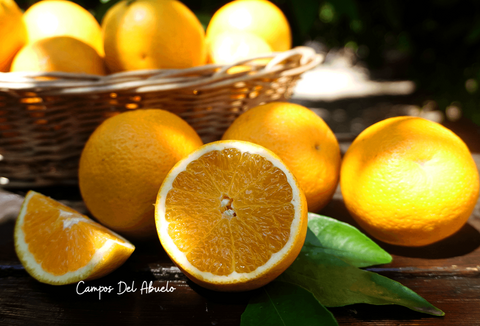
The varieties that, at the same time as they are flowering, the orange is still on the tree are the late varieties . The tiny orange that is being made is combined with the orange that is still on the tree .
However , those that are picked earlier do not allow this. If you leave the orange on the tree, it inhibits flowering. In other words, if the orange that is picked between November and January is left on the tree and you pick it at the end of March or April, it inhibits flowering .
It is not known why. There are studies at the Polytechnic of Valencia on this, as well as great experts who have been conducting studies for many years and it is not known why this happens.
It is quite incredible that there is still no explanation for what happens with oranges. Eduardo reinforces this difference between oranges that are considered early and late .
The late ones are made for that, it doesn't matter if you harvest them earlier, it doesn't give better fruit. On the other hand, with the ones that are harvested earlier it's like, let's see... It's like a mother who carries four children in her arms, the sooner she puts them down on the ground, the sooner they will rest. It's the same with oranges. The orange that has to be picked in April, May and June, if you pick it in April better than in June, the tree will rest sooner.
In addition to their harvest time, oranges are classified into three groups , and within these we have, in turn, different oranges with their own characteristics. Let's start with the first ones.
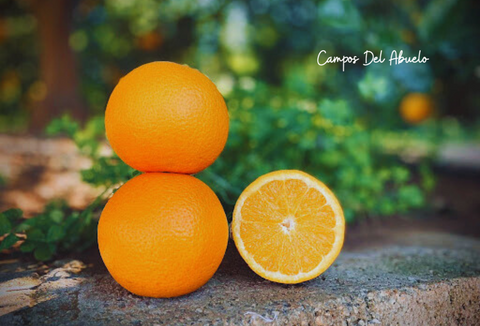
The navel group
Navel oranges are characterized by being large, thick oranges with a “navel” shaped end (hence “navel” which means “navel” in English). As they do not have seeds, their flavor is more intensified. They are what we know as table oranges.
In Valencia , the varieties within the navel group that we can find are:
In the following graph you can see when each one is in season.
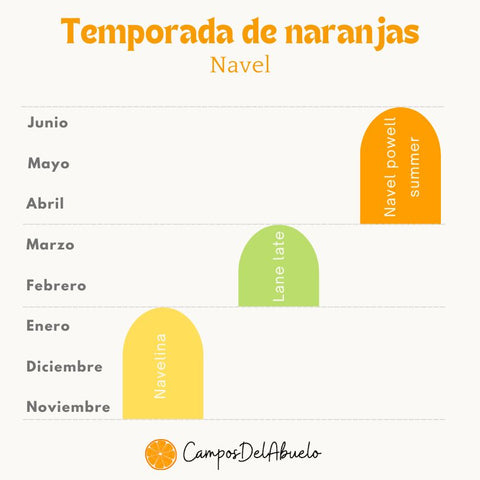
The White Group
The oranges in the white group have smoother skin and more juice. Their fleshy, water-rich and sweet segments make them ideal for making juice . It is worth clarifying that they are not white, but… well, orange in colour. Let's see which are the most cultivated in Valencia within this group:

Ok, let's get a little serious. It is common to find Valencia Late oranges in August and September. But as you can see in the graph above, these oranges end their season in July, so the oranges you find in supermarkets or warehouses during those months are stored in cold storage and treated with post-harvest products to make them last longer.
That is why we at Campos del Abuelo are giving you this important piece of information: in August and September there are no oranges on the trees and we recommend that you consume other types of seasonal fruit during these two months.
Later you can return to our website for the best oranges in Spain. Having made this clarification, we can go to the last group.

The Sanguine group
The blood orange, as its name suggests, is red in colour , both in its flesh and in its juice. This colour is due to the fruit being exposed to very low night-time temperatures. Other names by which it is known are: blood orange, red orange or bull's blood orange.
There are different varieties that can be found between February and May. Its flavour has a contrast between acidity and sweetness. It is usually grown in Italy, although there are also some areas in Spain where it is produced.
Its particular color is explained by the presence of natural anthocyanin pigments , which in turn provide a large amount of antioxidants.
Eduardo is right when he says that the world of oranges is very fascinating . From its origins, through its cultivation and varieties, the orange has shown us to be complex.
It is a lot of work to take care of the trees , to be next to them in the sun or in the rain, to make sure they have enough nutrients, that they are setting enough fruit... But at the same time, if you give to them, they are very generous in what they give back.
There is no doubt that nature is amazing and provides us with everything we need. And not only in the sense that oranges are really delicious in juice or however you want to eat them, but because they provide multiple benefits . Do we know them?

Benefits of eating oranges
These are some of the benefits of adding Valencian orange to your diet:
- This is perhaps the best known of all: a glass of orange juice a day covers the daily requirement of vitamin C.
- Increases the absorption of iron, calcium and phosphorus .
- It has antioxidant properties .
- Contains fiber and flavonoids that strengthen the immune system.
- They are rich in thiamine and folic acid , two B vitamins essential for the nervous system.
- In the case of blood oranges, they contain beta-carotene, which provides vitamin A.
Far from knowing it by recommendation of the medical or scientific community and more by the side of what the grandmother said, oranges help us to fight colds or flu . This is because they are antiviral, antibacterial and neutralize the action of free radicals.
Answering the question…
There are several reasons why Valencia oranges are considered the best in the world . One of them is their unique flavour and incomparable juiciness. We cannot underestimate the fact that the orange does quite a lot on its own, as it is a truly delicious fruit...
But we also have another point that is no less important: they are grown in a careful process , always paying attention to what the tree needs. This enhances their taste when eating them and achieves that sweet aroma with a touch of acid.
To close this article on Valencian oranges, we asked Eduardo one last question: What makes Valencian oranges so well-known worldwide? And his answer was the following:

Very simple, in addition to fertile lands , we have a climate that is at the limit. That is, it is as cold as it should be without freezing, but always at the limit . This makes the orange take on the red color, because the color is given precisely by the cold.
Then, during the day, temperatures rise and we have milder temperatures, which means that the orange has more sugar content, which is why they are so good, they meet all the conditions: acidity, sweetness, colour, everything.
That's right, just as Eduardo says: they meet all the conditions to be the best .
There is no longer any doubt that the path of oranges had its destiny in Valencia. Not only have they managed to establish themselves perfectly, but they are also part of a historical tradition.
From Campos Del Abuelo we invite you to be part of this tradition, buying seasonal fruit directly from the farmer to your table.
Until next time and thanks for reading!

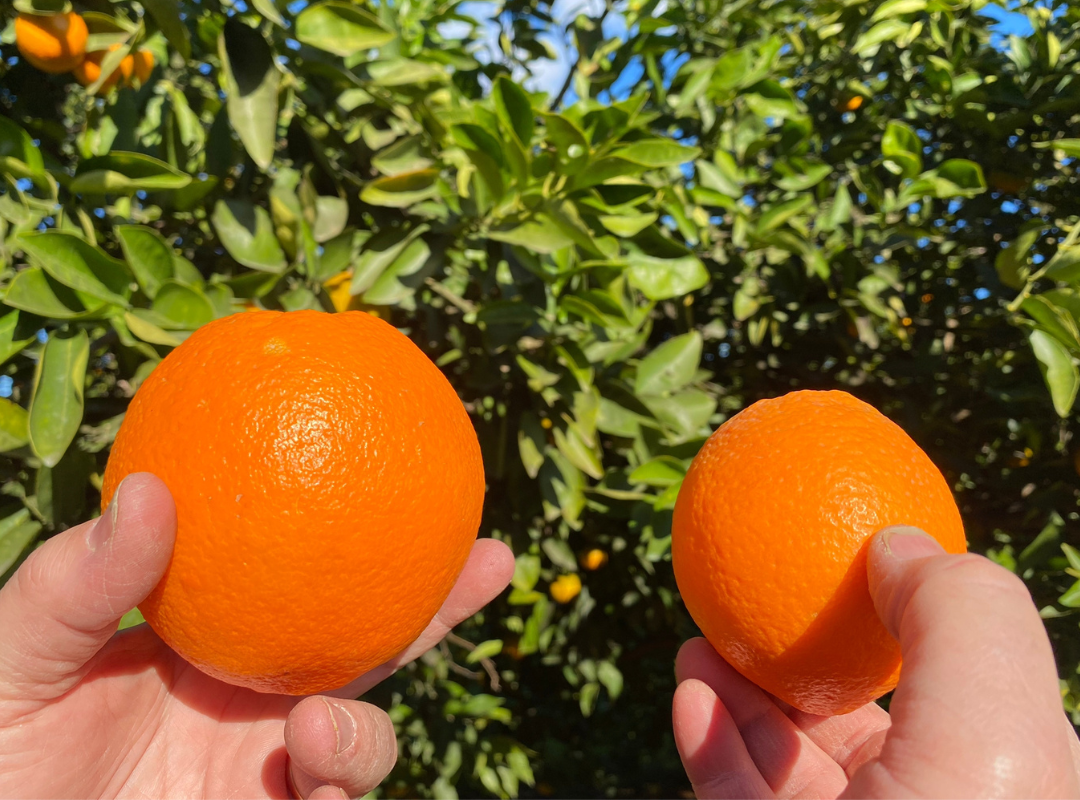




Comments
Valencia oranges are truly the best verity in the orange kingdom , their sweetness cannot just be bypassed by any other verity.
This was a very interesting and educational article! I really enjoyed reading it! Thank you for this wonderful and informative article/story of Vencia oranges!